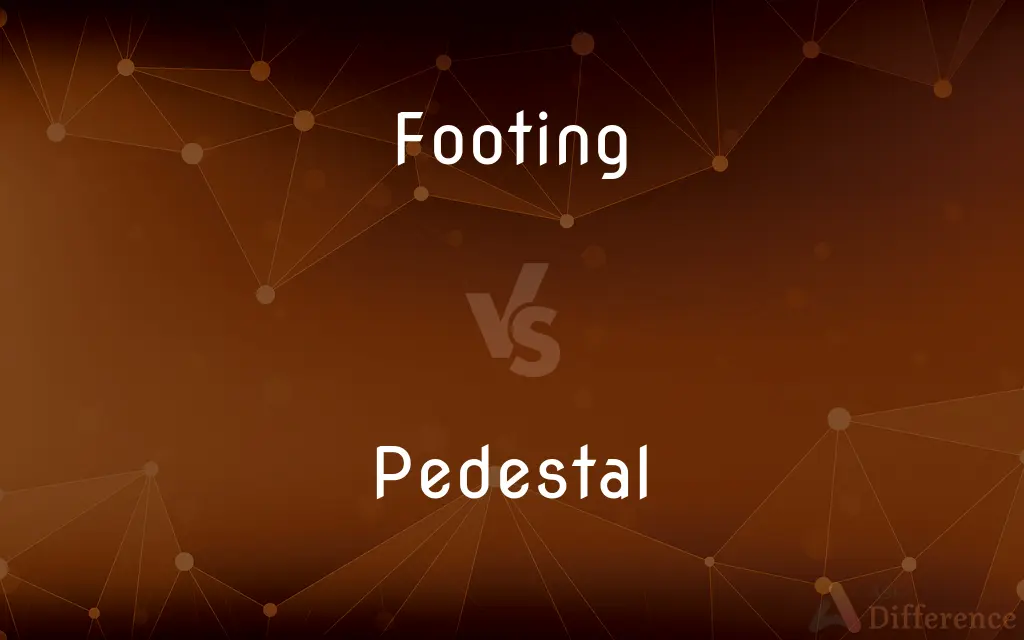Footing vs. Pedestal — What's the Difference?
By Maham Liaqat & Urooj Arif — Updated on March 25, 2024
Footing is a structural foundation element spreading loads to prevent sinking, while a pedestal elevates and supports structures or objects above its base.

Difference Between Footing and Pedestal
Table of Contents
ADVERTISEMENT
Key Differences
Footing and pedestal serve different roles in construction and architecture, both crucial for stability and support, but with distinct purposes and designs. In contrast, a pedestal is used to elevate and support structures or objects above its base, highlighting them or making them more accessible.
While footings are essential for the structural integrity of buildings and are usually hidden below ground level, pedestals are both functional and decorative, often visible and designed to complement the aesthetics of what they support. The key difference lies in their application: footings are a critical part of the building's foundation system, whereas pedestals serve to elevate and enhance the presentation of objects or structural components.
Footings and pedestals, despite their differences, are fundamental in construction and design, each contributing to the safety, functionality, and aesthetics of buildings and spaces. Understanding their specific roles and applications is essential for architects, engineers, and designers in creating stable, durable, and visually pleasing structures and displays.
Footings are typically made of reinforced concrete and are designed based on the load they must carry and the soil's bearing capacity. Pedestals can be found in various contexts, from architecture to display settings, where they raise statues, vases, or other decorative items for better visibility or prominence.
Comparison Chart
Purpose
Spreads structural loads to prevent sinking
Elevates and supports structures or objects
ADVERTISEMENT
Location
Below ground level, part of the foundation
Above ground, can be part of the structure or standalone
Material
Commonly reinforced concrete
Varies, including concrete, stone, metal, or wood
Design Consideration
Load distribution and soil bearing capacity
Support, accessibility, and aesthetics of the supported object
Functionality
Structural integrity and stability
Elevation, visibility, and enhancement of supported items
Compare with Definitions
Footing
A structural foundation component spreading loads to soil.
The building's stability is ensured by deep footings.
Pedestal
Elevates and supports objects or structures.
The statue stood on a marble pedestal at the gallery's entrance.
Footing
Prevents uneven settling or sinking.
Proper footings prevent structural damage in uneven terrains.
Pedestal
Can be decorative and functional.
The garden's pedestals were ornately designed yet sturdy.
Footing
Designed based on soil bearing capacity.
Engineers calculated the size of the footing needed for the new bridge.
Pedestal
Used for display or architectural enhancement.
A series of pedestals displayed the artifacts in the museum.
Footing
Critical for the building's structural system.
Footings are inspected thoroughly to ensure long-term stability.
Pedestal
Varies in material and design.
Wooden pedestals were used to elevate potted plants indoors.
Footing
Lies at the base of foundations or columns.
Column footings were poured to support the overhead structure.
Pedestal
Enhances visibility and prominence.
The award was placed on a pedestal for everyone to see during the ceremony.
Footing
Secure placement of the feet in standing or moving.
Pedestal
A pedestal (from French piédestal, Italian piedistallo 'foot of a stall') or plinth is the support of a statue or a vase, and of a column in architecture. Smaller pedestals, especially if round in shape, may be called socles.
Footing
A surface or its condition with respect to its suitability for walking or running, especially the condition of a racetrack.
Pedestal
An architectural support or base, as for a column or statue.
Footing
A secure place for the feet; a foothold.
Pedestal
A support or foundation.
Footing
The act of moving on foot.
Pedestal
A position of high regard or adoration.
Footing
(Architecture) The supporting base or groundwork of a structure, as for a monument or wall. Also called footer.
Pedestal
To place on or provide with a pedestal.
Footing
A basis or foundation
A business begun on a good footing.
Pedestal
(architecture) The base or foot of a column, statue, vase, lamp.
Footing
Position or rank in relation to others; standing
Everyone began on an equal footing.
Pedestal
(figuratively) A place of reverence or honor.
He has put his mother on a pedestal. You can't say a word against her.
Footing
Terms of social interaction
Neighbors on a friendly footing.
Pedestal
(rail transport) A casting secured to the frame of a truck of a railcar and forming a jaw for holding a journal box.
Footing
The act of making a foot for something, such as a stocking.
Pedestal
(machining) A pillow block; a low housing.
Footing
The sum of a column of figures.
Pedestal
(bridge building) An iron socket, or support, for the foot of a brace at the end of a truss where it rests on a pier.
Footing
A ground for the foot; place for the foot to rest on; firm foundation to stand on.
Pedestal
(steam heating) a pedestal coil, group of connected straight pipes arranged side by side and one above another, used in a radiator.
Footing
A standing; position; established place; foothold.
Pedestal
(telecommunications) A ground-level housing for a passive connection point for underground cables.
Footing
A relative condition; state.
Pedestal
(electronics) The measured value when no input signal is given.
Footing
(dated) A tread; step; especially, a measured tread.
Pedestal
(aviation) The central part of the cockpit, between the pilots, where various controls are located.
Footing
(rare) A footprint or footprints; tracks, someone's trail.
Pedestal
The tough protuberant pad covering a dromedary's sternum, which, when the camel lies down, causes the abdomen to be slightly above the hot ground.
Footing
Stability or balance when standing on one's feet.
He lost his footing and fell down.
It was difficult to keep my footing on the ship during the storm.
Pedestal
To set or support on (or as if on) a pedestal.
Footing
The act of adding up a column of figures; the amount or sum total of such a column.
Pedestal
The base or foot of a column, statue, vase, lamp, or the like; the part on which an upright work stands. It consists of three parts, the base, the die or dado, and the cornice or surbase molding. See Illust. of Column.
Build him a pedestal, and say, "Stand there!"
Footing
The act of putting a foot to anything; also, that which is added as a foot
The footing of a stocking
Pedestal
A short free-standing column or column-like object designed to support a work of art or other object; a column serving the same function as the base of a statue. It may be made of wood, marble, or other suitable material.
Footing
A narrow cotton lace, without figures.
Pedestal
A part of a desk which contains a frame and drawers, stands on the floor, and provides support for the desk surface. There may be zero, one, or two such pedestals in a desk.
Footing
The finer refuse part of whale blubber, not wholly deprived of oil.
Pedestal
A casting secured to the frame of a truck and forming a jaw for holding a journal box.
Footing
The thickened or sloping portion of a wall, or of an embankment at its foot; foundation.
Pedestal
A support or foundation;
The base of the lamp
Footing
(accounting) A double-check of the numbers vertically.
Pedestal
A position of great esteem (and supposed superiority);
They put him on a pedestal
Footing
Present participle of foot
Pedestal
An architectural support or base (as for a column or statue)
Footing
Ground for the foot; place for the foot to rest on; firm foundation to stand on.
In ascent, every step gained is a footing and help to the next.
Footing
Standing; position; established place; basis for operation; permanent settlement; foothold.
As soon as he had obtained a footing at court, the charms of his manner . . . made him a favorite.
Footing
Relative condition; state.
Lived on a footing of equality with nobles.
Footing
Tread; step; especially, measured tread.
Hark, I hear the footing of a man.
Footing
The act of adding up a column of figures; the amount or sum total of such a column.
Footing
The act of putting a foot to anything; also, that which is added as a foot; as, the footing of a stocking.
Footing
A narrow cotton lace, without figures.
Footing
The finer refuse part of whale blubber, not wholly deprived of oil.
Footing
The thickened or sloping portion of a wall, or of an embankment at its foot.
Footing
Status with respect to the relations between people or groups;
On good terms with her in-laws
On a friendly footing
Footing
A relation that provides the foundation for something;
They were on a friendly footing
He worked on an interim basis
Footing
A place providing support for the foot in standing or climbing
Common Curiosities
How do footings contribute to a building's longevity?
By evenly distributing the structure's weight to the soil, footings prevent sinking and structural damage, ensuring longevity.
Can pedestals be considered part of a building's foundation?
Pedestals are generally not considered part of a building's foundation; they're more for elevation and support above ground level.
In what contexts might you find pedestals used?
Pedestals are used in architectural designs, museums, galleries, and landscaping to elevate and display objects.
What is the main difference between footing and pedestal?
Footing is a foundational element that distributes load to the soil, while a pedestal elevates and supports objects above its base.
Are there different types of footings?
Yes, there are several types, including strip footings, pad footings, and raft footings, each designed for specific load requirements.
How are footings and pedestals similar?
Both are structural elements that provide support, though in different ways and for different purposes.
What factors influence the design of a footing?
The design is influenced by the structure's weight, the type of soil, and the soil's bearing capacity.
Why might a designer choose to use a pedestal in a space?
A designer might use a pedestal to highlight an object, improve a space's aesthetics, or make an item more accessible to viewers.
How do the materials used for pedestals vary?
Pedestal materials range based on intended use and aesthetic goals, from durable concrete for outdoor use to fine wood and metals for interiors.
Can a pedestal have a functional purpose beyond elevation?
Yes, beyond elevation, pedestals can enhance an object's visibility, accessibility, and aesthetic presentation.
Share Your Discovery

Previous Comparison
Ribeye vs. Tenderloin
Next Comparison
Instrumentation vs. InstrumentAuthor Spotlight
Written by
Maham LiaqatCo-written by
Urooj ArifUrooj is a skilled content writer at Ask Difference, known for her exceptional ability to simplify complex topics into engaging and informative content. With a passion for research and a flair for clear, concise writing, she consistently delivers articles that resonate with our diverse audience.














































